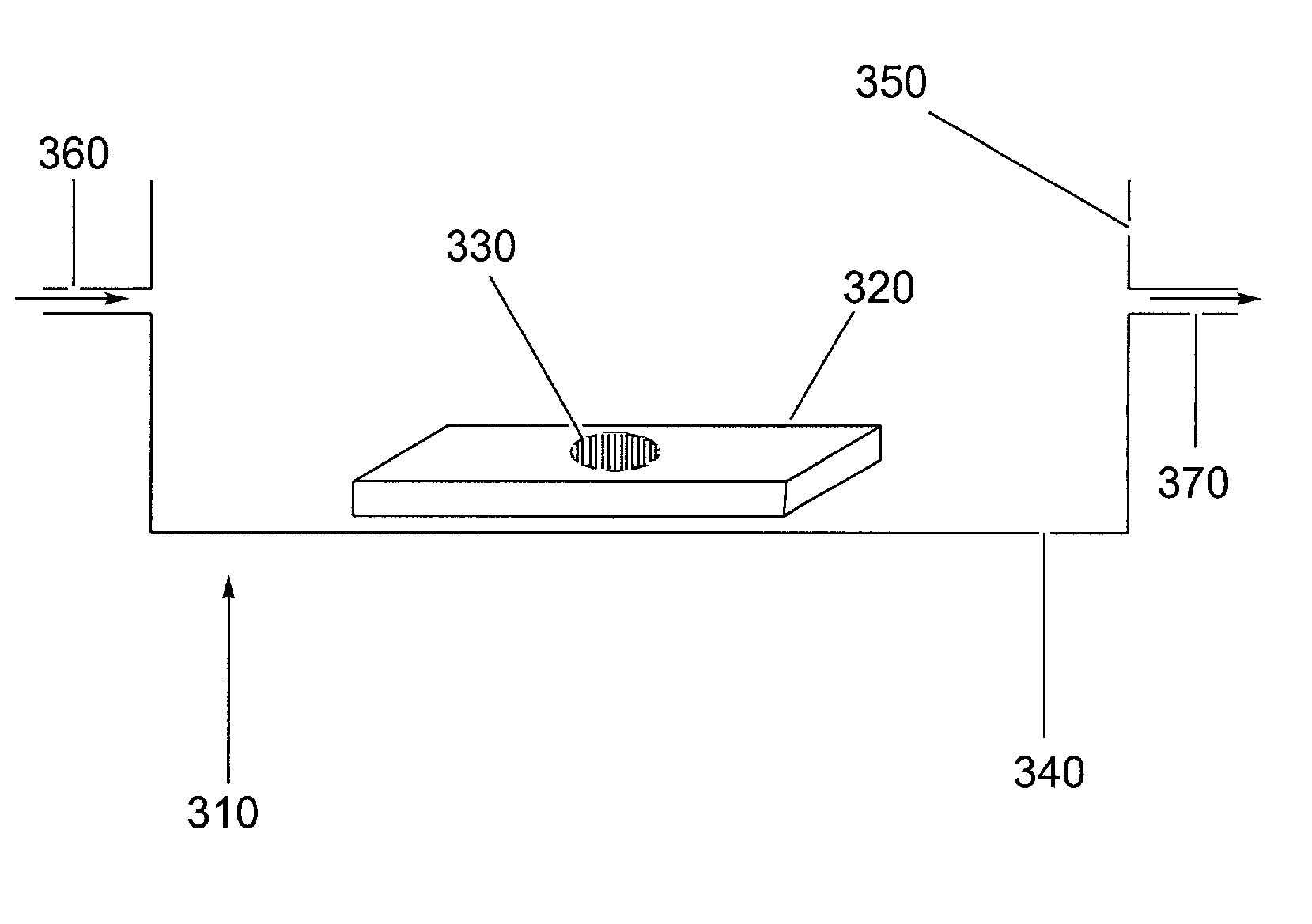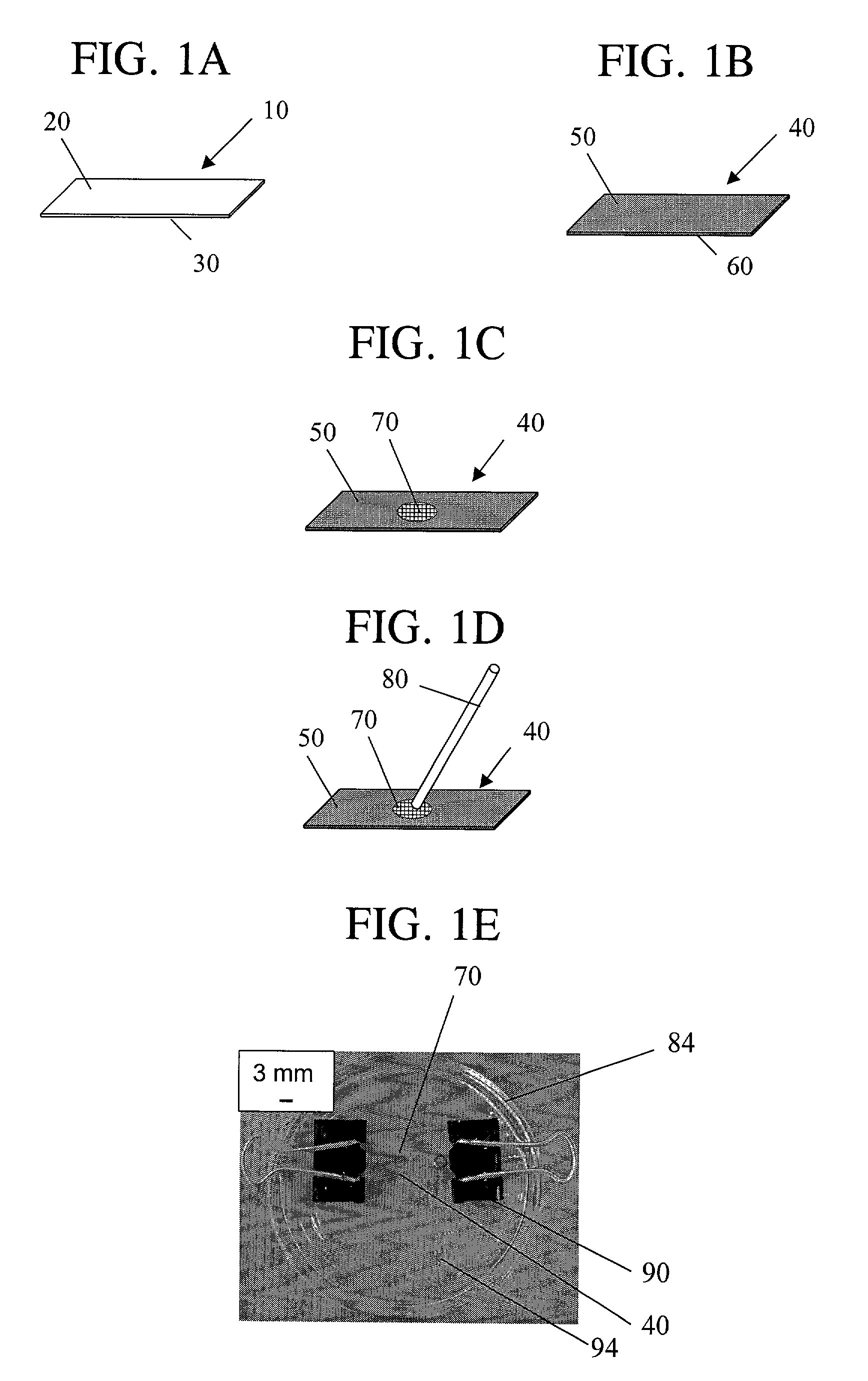Detecting interactions at biomimetic interfaces with liquid crystals
a biomimetic interface and liquid crystal technology, applied in biomass after-treatment, applications, instruments, etc., can solve the problems of difficult routine use in the field, low detection efficiency, and high cost of methods, and achieve the effect of improving the detection efficiency and reproducibility of biomimetic interactions
- Summary
- Abstract
- Description
- Claims
- Application Information
AI Technical Summary
Benefits of technology
Problems solved by technology
Method used
Image
Examples
example 1
Formation of Stable DLPC Adsorbed Membrane on 5CB at Various Concentrations
[0119]5CB was confined to copper TEM grids (hole size of 292 μm and thickness of 18–20 μm) placed on OTS-treated glass slides by contacting a 1 μL droplet of 5CB with the grid. Excess 5CB was removed by contacting a 25 μL capillary tube with the 5CB. The resulting film of 5CB confined to the grid was quickly immersed in and withdrawn from deionized water. The 5CB impregnated grid on the OTS-treated glass slide was then immersed in vesicle solutions of DLPC at various concentrations in 10 mM phosphate, 100 mM sodium chloride buffer at pH 8.9. In cases where the alignment of the 5CB after exposure to DLPC resulted in homeotropic anchoring of 5CB, the DLPC solution was exchanged with a pure buffer not containing DLPC while keeping the 5CB constantly immersed in the aqueous phase. The optical appearance of the 5CB was monitored using a light microscope with crossed polarizers. All images shown were taken at a mag...
example 2
Interaction of Cytochrome c with DLPC Adsorbed on 5CB
[0121]5CB was confined to copper TEM grids (hole size of 292 μm and thickness of 18–20 μm) placed on an OTS-treated glass slide by contacting a 1 μL droplet of 5CB with the grid. Excess 5CB was removed by contacting a 25 μL capillary tube with the 5CB. The resulting film of 5CB confined to the grid was quickly immersed in and withdrawn from deionized water. The 5CB impregnated grid on the OTS-treated glass slide was then immersed in a 0.1 mM vesicle solution of DLPC in 10 mM phosphate, 100 mM sodium chloride buffer at a pH of 8.9. After a layer of DLPC was adsorbed between the 5CB and aqueous phase, indicated by the transition of the alignment of 5CB to a homeotropic alignment, the aqueous solution was exchanged with a 10 mM phosphate, 100 mM sodium chloride buffer at pH 8.9 which contained no DLPC. During this exchange, the DLPC-laden 5CB interface remained continuously immersed in the aqueous phase. Cytochrome c was then injecte...
example 3
Interaction of BSA with DLPC Adsorbed on 5CB
[0123]5CB was confined to copper TEM grids (hole size of 292 μm and thickness of 18–20 μm) placed on OTS-treated glass slides by contacting a 1 μL droplet of 5CB with the grid. Excess 5CB was removed by contacting a 25 μL capillary tube with the 5CB. The resulting film of 5CB confined to the grid was quickly immersed in and withdrawn from DI water. The 5CB impregnated grid on the OTS-treated glass slide was then immersed in a 0.1 mM vesicle solution of DLPC in 10 mM phosphate, 100 mM sodium chloride buffer at a pH of 8.9. After a layer of DLPC was adsorbed between the 5CB and aqueous phase, indicated by the transition of the alignment of 5CB to a homeotropic alignment, the aqueous solution was exchanged with a 10 mM phosphate, 100 mM sodium chloride buffer at pH 8.9 which contained no DLPC. During this exchange, the DLPC-laden 5CB interface remained continuously immersed in the aqueous phase. Bovine serum albumin was then injected into the...
PUM
| Property | Measurement | Unit |
|---|---|---|
| pH | aaaaa | aaaaa |
| thickness | aaaaa | aaaaa |
| thickness | aaaaa | aaaaa |
Abstract
Description
Claims
Application Information
 Login to View More
Login to View More - R&D
- Intellectual Property
- Life Sciences
- Materials
- Tech Scout
- Unparalleled Data Quality
- Higher Quality Content
- 60% Fewer Hallucinations
Browse by: Latest US Patents, China's latest patents, Technical Efficacy Thesaurus, Application Domain, Technology Topic, Popular Technical Reports.
© 2025 PatSnap. All rights reserved.Legal|Privacy policy|Modern Slavery Act Transparency Statement|Sitemap|About US| Contact US: help@patsnap.com



